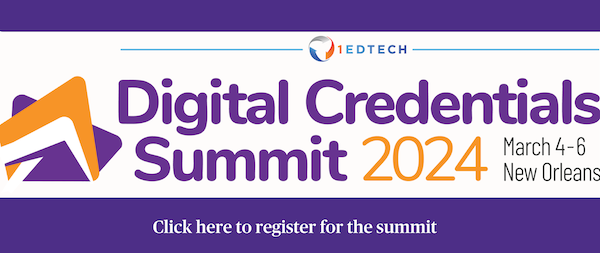Published on
From Novelty to Necessity: Strategic Microcredential Development and Universal Recognition in Higher Ed

Microcredentials are swiftly gaining recognition in higher education, but not everyone is onboard—yet. As they become increasingly popular, what’s needed is a strategy behind every decision on credentials. Without it comes chaos. In this interview, Erica Noll-Crawford discusses why microcredentials can’t be rolled out without strategy, how to align them to industry needs and what it’ll take to grow and scale them across the institution.
The EvoLLLution (Evo): Why is it important for higher ed leaders to focus on strategically developing microcredentials?
Erica Noll-Crawford (ENC): The world of work has changed so dramatically. With The Great Resignation and the pandemic, people are changing jobs more regularly than ever before. There is also The Tear the Paper Ceiling campaign, where Opportunity@Work is advocating for companies to remove degree requirements from jobs that do not necessarily need a degree to be done successfully. So, higher ed really has to step up its game if it wants to keep up.
That said, microcredentials must be intentional. Higher ed often wants to create cool, new degrees that might sound fun, but don’t have a true job market for. They also might turn to Microcredentials to do the same thing—building a program out for fun or personal interest rather than for Workforce Development. However, we’ve found that it’s better when creating microcredentials is an intentional process. At Miami University Regionals, we don’t approve new microcredentials unless a business or industry signs off on it. We want students to have job opportunities with these credentials, so we must have strategy and meaning behind what we create or offer.
Evo: Do you work in partnership with industry to get that sign-off, or is it more like an advisory committee?
ENC: It’s a little bit of both. We often start by working with companies to figure out their needs and what workforce gaps they are experiencing. This helps inform our faculty, so they know what to look for in our existing courses. Other times, we will look at general industry trends and state to see where there is demand. Either way, we do always make sure to have a company or community partner review our proposal to ensure it meets a workforce need.
Evo: What does it take to roll out innovative credentialling across the institution?
ENC: First thing that comes to mind is time. It’s certainly a culture shift and a more innovative way of doing things. Higher ed isn’t known for being fast, so getting buy-in on something like this takes time. We started small: ten programs with different departments that we knew would be on board. Then these programs would become case studies for other departments, expanding this idea from a handful of programs to now over thirty offerings. But it definitely takes a lot of time and buy-in from leadership, faculty and staff.
Evo: What are some of the biggest strategic or operational roadblocks to broad acceptance of microcredentials?
ENC: Defining terms is certainly a roadblock. You have to start with a strong definition of what a microcredential is and what it means. The breadth of microcredentials and their definitions today vary so much across the higher ed space. There are also a lot of operational processes that you have to figure out as well. Who’s going to sign off and decide whether or not a microcredential should proceed? You need a solid foundation in place to grow a program in the long term. Lastly, you will need to get buy-in from across campus. Bringing everyone to the same table so you can move in the same direction is key to having seamless processes.
Evo: What are some best practices to grow and scale microcredentials?
ENC: You have to show people what’s in it for them. Faculty members are burnt out and exhausted. Taking on another project may feel like just another project. To get their buy-in, they need to know what’s in it for them: fewer empty seats in their classes and possibly more students in their programs. Those who choose a microcredential may end up taking a degree. Once they get the gist of the college experience and dispel some of their fears, uncertainties and anxieties, those who never thought they wanted a degree may decide to pursue one. In addition, we strive to make sure it is a light lift for our faculty partners. For example, we often offer to help with the paperwork to propose a new microcredential. That way, instead of having to complete a multi-page document, we only ask them to provide some key information and review the final product. It makes it much easier for them to actually get a microcredential going, while ensuring it has the academic expertise and rigor their programs deserve.
In addition, higher ed should remember that we don’t need to reinvent the wheel. We already courses that have been created and vetted by experts in their fields. Why not use those instead of creating a new training program from scratch? By utilizing what we already have available in the form of currently offered courses, we’re not spending time or money building a whole new training program that we hope a company might buy into. Instead, we are repackaging what we already have to offer, making it a much lighter lift for us, all while meeting the needs of our local businesses and company partners. We haven’t reinvented the wheel—just improved it, creating new variations for different uses.
Evo: What impact do microcredentials have on student recruitment?
ENC: Students today aren’t looking for degree programs—they want short-term credentials. So, if a school isn’t offering short-term credentials, then it will never be on their radar. They’ll go somewhere that does offer it. Microcredentials get a student’s foot in the door by giving them the opportunity to dip their toe into higher education. Doing so may encourage them to decide to pursue a long-term degree, but they also may just decide that the short-term credential is all they need. Either way, we are helping students meet their goals.
Credentials also provide some of the instant gratification that students are looking for. Instead of waiting two or four years for a degree, they have something tangible right now. It can also help encourage them to take an additional class or two to earn a microcredential. It feels like the end goal is more within their reach. Life can get in the way, so we need to offer more flexible options. Microcredentials can provide that.
Evo: Is there anything you’d like to add about microcredentials?
ENC: The biggest thing to keep in mind is to work collaboratively. Work with your partners, industry, state and region. The best way to make a model that you can get up and going quickly is by using what you already have. Don’t get stuck in a time suck or money pit to get this going. Look around first.
This interview was edited for length and clarity.

Author Perspective: Administrator



